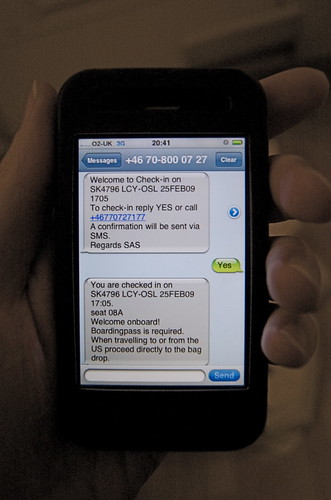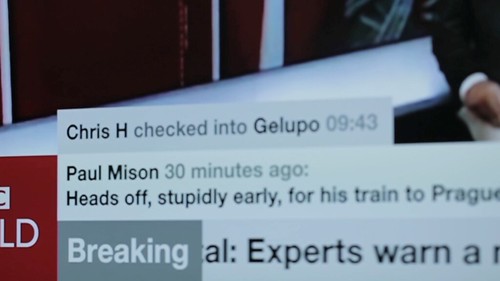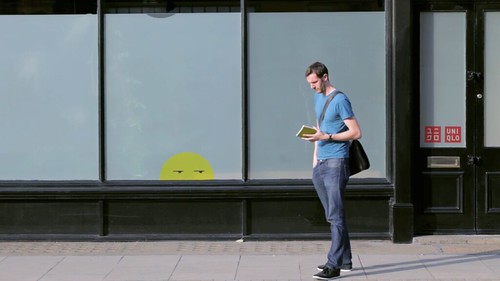Following iPad light painting, we’ve made two films of alternative futures for media. These continue our collaboration with Dentsu London and Timo Arnall. We look at the near future, a universe next door in which media travels freely onto surfaces in everyday life. A world of media that speaks more often, and more quietly.
Incidental Media is the first of two films.
The other film can be seen here.
Each of the ideas in the film treat the surface as a focus, rather than the channel or the content delivered. Here, media includes messages from friends and social services, like foursquare or Twitter, and also more functional messages from companies or services like banks or airlines alongside large traditional big ‘M’ Media (like broadcast or news publishing).
All surfaces have access to connectivity. All surfaces are displays responsive to people, context, and timing. If any surface could show anything, would the loudest or the most polite win? Surfaces which show the smartest most relevant material in any given context will be the most warmly received.
I recently encountered this mixing in surfaces. An airline computer spoke to me through SMS. This space is normally reserved for awkwardly typed highly personal messages from friends. Not a conversational interface with a computer. But now, those pixels no longer differentiate between friends, companies and services.
Mixing Media
How would it feel if the news ticker we see as a common theme in broadcast news programmes begun to contain news from services or social media?
I like the look of it. The dominance of linear channel based screens is distorted as it shares unpredictable pixels and a graphic language with other services and systems.
Ambient listening
This screen listens to its environment and runs an image search against some of the words it hears. I’ve long wanted to see what happens if the subtitles feed from BBC television broadcast content was tied to an image search.
It feels quite strange to have a machine ambiently listening to words uttered even if the result is private and relatively anodyne. Maybe it’s a bit creepy.
Print can be quick
This sequence shows a common receipt from a coffee shop and explores what happens when we treat print as a highly flexible, context-sensitive, connected surface, and super quick by contrast to say video in broadcast.
The receipt includes a mayorship notification from foursquare and three breaking headlines from the Guardian news feed. It turns the world of ticket machines, cash registers and chip-and-pin machines into a massive super-local, personalised system of print-on-demand machines. The receipt remains as insignificant and peripheral as it always has, unless you choose to read it.
Computer vision
The large shop front shows a pair of sprites who lurk at the edges of the window frames. As pedestrians pass by or stand close, the pair steal colours from their clothes. The sketch assumes a camera to read passers-by and feed back their colour and position to the display.
Computer vision installations present interesting opportunities. Many installations demand high levels of attention or participation. These can often be witty and poetic, as shown here by Matt Jones in a point of sale around Lego.
We’ve drawn from great work from the likes of Chris O’Shea and his Hand from Above project to sketch something peripheral and ignorable, but still at scale. The installation could be played with by those having their colours stolen, but it doesn’t demand interaction. In fact I suspect it would succeed far more effectively for those viewing from afar with no agency over the system at all.
In contrast to a Minority Report future of aggressive messages competing for a conspicuously finite attention, these sketches show a landscape of ignorable surfaces capitalising on their context, timing and your history to quietly play and present in the corners of our lives.
Incidental Media is brought to you by Dentsu London and BERG. Beeker has written about the films here.
Thank you to Beeker Northam (Dentsu London), and Timo Arnall, Campbell Orme, Matt Brown, and Matt Jones!





25 Comments and Trackbacks
1. Sam said on 3 November 2010...
Really like the playful and ignorable, but can’t see many sticking to those rules. If the context was deep, then you might be onto something, but I’d imagine this sort of treatment would quickly descend to common denominators.
2. Justin Pickard said on 3 November 2010...
The near-total disembodiment of Stephen Fry is slightly uncanny, yes, but in a good way. Second-order media cyborg, with something lost/transformed in the translation of inputs? Either way, deserves further investigation. Just promise you won’t do it to The Archers!
3. Tristan said on 3 November 2010...
Here’s a radio interview with Steve Reich; transcribed, keyword-extracted and then represented as “interesting” photos (from some other experiments). Unfortunately we still don’t do subtitles for radio, though we do have TV subtitle feeds…
4. Carlos said on 3 November 2010...
At the end everything is going to be set up in just one device i liked the mixing media concept. Cool material guys keep on going!
5. vanderwal said on 4 November 2010...
I really enjoyed the train schedule clicking updating interface, which would be a nice screen saver. A wonderful view again. Thanks!
6. catterwaul said on 4 November 2010...
As neat as some of the tech was, I was disappointed and found the world that they’re proposing a noisy mess. The way they are trying to present their premise is rather “utopian”…but I think they’re more interested in the “gee whiz” factor of machines that “goof off” when not in use and cute animations that “interact” with you. Even their “playful”/”ignorable” screen scenarios still demand attention simply by being visual information. The human brain is wired to react to stimuli like audio and visual cues, and if all we’re doing is filling blank spaces with more “noise” (bouncy balls…Stephen Fry narrated Google image searches), that’s all that it becomes…more noise.
Again…like the tech – it IS cute.
However, in this world of more and more informational overload (which it sounds like they’re trying to address…and, in my opinion, failing at) people are beginning to value less and less “noise”, and are beginning to see the value in the concept of “silence” (a radio that is OFF, a blank piece of paper, a window, that is just a window).
7. Eric Rodenbeck said on 6 November 2010...
love the videos – a couple of ’em are private on flickr, jfyi
8. Amit said on 16 November 2010...
This appears akin to some of the ideas in this fabulous talk by Pranav Mistry
9. tom sanders said on 30 August 2011...
I love the notion that ‘print can be quick’ – transforming this traditionally slow and static media into something lively and instant is much needed. There’s a danger that flat media is becoming redundant in this new world of screens, but this shows a smart way for a brand to capitalise on the (social) content that is available to them and bring it into the temporal world.
10. Trowy said on 29 September 2011...
Brilliant
11. Paul del Rosario said on 21 January 2013...
Nice videos, inspiring ideas. Minority Report a step closer.
Trackback: Incidental Media | Born05 Inspiratie Blog 16 November 2010
[…] thought, the makers of this short film looked at the surface instead of the media. This results in screens and surfaces […]
Trackback: Mayo Nissen » City Tickets – a possible ecology 23 November 2010
[…] City Tickets very similar to the ones I proposed from existing parking ticket machines could also be available from kiosks, corner shops, post offices, and supermarkets. In Copenhagen, each of these already has a custom-ish receipt printer that lets them sell mobile phone credit – the receipt you get also has instructions, and a code to put the credit on your phone, etc, in addition to being a receipt and telling you how much it cost. The same thing goes for the National Lottery receipts you get in the UK, which tell you which lucky numbers you selected. There’s no reason these can’t also print other things if you ask for it; or maybe every receipt has a city ticket bit attached or on the back. It would be interesting to think about how they might be different to the ones I designed for the parking ticket machines – would the map be the same scale? Would there be different fields to fill in, depending which type of store you got it from? Would it be co-branded with the store? Would the same store also work as an additional ‘input’ location, which I’ve currently defined as post boxes. See also BERG’s lovely exploration of the possibilities of microprinting in their recent videos. […]
Trackback: Taking these Yahoo Widgets on my Samsung TV for a test drive…|Coole Live Ticker Bilder | Fussball 5 February 2011
[…] Social screensavers (watch this, about 0:50 in) + Social tickers (Twitter, Facebook) + USB video / Google chat w/ video support + […]
Trackback: Towards a beautiful, broken future | Nordkapp Blog 3 March 2011
[…] designing things just intelligent enough to be polite, riffing on Matt Jones’s BASAAP and BERG’s work with Dentsu London. A question was made whether I would agree or disagree with Adam on the need for […]
Trackback: Signals, Knowledge, ‘Ambient’ Learning | to. wa. - walking on the insight road (and not halfway there). 4 August 2011
[…] goes more into the direction that Berg London (with Dentsu London and Timo Arnall) take with their concept of incidental media. Each of the ideas in the film treat the surface as a focus, rather than the channel or the content […]
Trackback: Berg’s Charming Disruption | Sophie Trinder 1 December 2011
[…] a headache from all the brightly lit cheap screens which will start to intrude on us in our lives. Berg’s ‘incidental media’ videos on the other hand, explore the future with media in a less sinister, positive light. They […]
Trackback: Interaction & Innovation | Blog @ manikrathee.com 31 January 2012
[…] that I had a pleasure of viewing recently. The first two are tied together and are called “Media Surfaces” – they deal with incidental media and determining what devices do when they […]
Trackback: Signals, Knowledge, ‘Ambient’ Learning | to. wa. 5 July 2012
[…] goes more into the direction that Berg London (with Dentsu London and Timo Arnall) take with their concept of incidental media. Each of the ideas in the film treat the surface as a focus, rather than the channel or the content […]
Trackback: The context economy: Integrating service, product and connectivity | 2030 radical design 12 July 2012
[…] Jack Schulze . 2010. Media Surfaces: Incidental Media. [ONLINE] Available at: http://berglondon.com/blog/2010/11/03/media-surfaces-incidental-media/. [Accessed 04 July 12]. Share this:TwitterFacebookLike this:LikeBe the first to like this. This […]
Trackback: Precedents | matsumoto thesis 2 October 2012
[…] Media Surfaces, Incidental Media, London (UK, founded 2010) and BERG (UK, founded 2005) […]
Trackback: Media is Everywhere | kakudai 21 January 2013
[…] between DENTSU UK / McGarryBowen and Berg; exploring “incidental media.” Imagine Facebook, Twitter, and all of your other […]
Trackback: Is Google Keep Better Than a Post-It? - Tech Talk | Tech Talk 21 March 2013
[…] is the phone–or as close to that as possible.) Yes, there is still a button to push to access the “media surface” of the app, but that’s still just one step. (You could say that a sticky note has one step of […]
Trackback: Facebook Home: Baby photos, engagement news and food porn coming to the screen nearest you. | Josh Akmens 6 April 2013
[…] London have re-imagined settings with smart, connected objects and ambient, ‘ignorable’ […]
Trackback: TBTB* (or Hyper/Links) « Visual Communication 14 April 2013
[…] Live surfaces, media surfaces. Augmented reality (think ‘clinic brief‘). Reality reality (think ‘everything else‘). Razzle Dazzle, and the New Aesthetic. Pixel Sorting for Dummies. […]